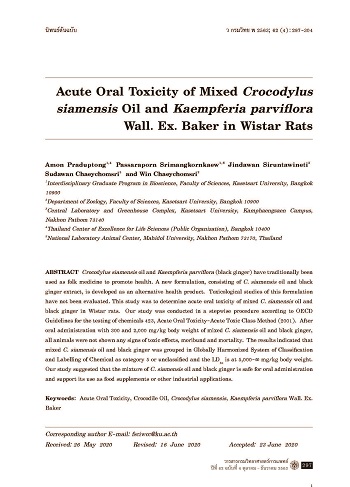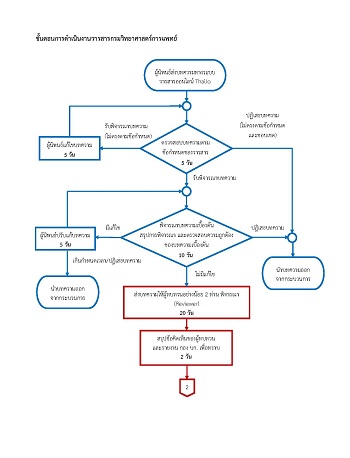Acute Oral Toxicity of Mixed Crocodylus siamensis Oil and Kaempferia parviflora Wall. Ex. Baker in Wistar Rats
Keywords:
Acute Oral Toxicity, Crocodile Oil, Crocodylus siamensis, Kaempferia parviflora Wall. Ex. BakerAbstract
Crocodylus siamensis oil and Kaempferia parviflora (black ginger) have traditionally been used as folk medicine to promote health. A new formulation, consisting of C. siamensis oil and black ginger extract, is developed as an alternative health product. Toxicological studies of this formulation have not been evaluated. This study was to determine acute oral toxicity of mixed C. siamensis oil and black ginger in Wistar rats. Our study was conducted in a stepwise procedure according to OECD Guidelines for the testing of chemicals 423, Acute Oral Toxicity-Acute Toxic Class Method (2001). After oral administration with 300 and 2,000 mg/kg body weight of mixed C. siamensis oil and black ginger, all animals were not shown any signs of toxic effects, moribund and mortality. The results indicated that mixed C. siamensis oil and black ginger was grouped in Globally Harmonized System of Classification and Labelling of Chemical as category 5 or unclassified and the LD50 is at 5,000-∞ mg/kg body weight. Our study suggested that the mixture of C. siamensis oil and black ginger is safe for oral administration and support its use as food supplements or other industrial applications.
References
Praduptong A, Srimangkornkaew P, Intana W, Siruntawineti J, Chaeychomsri S, Thitipramote N, et al. Primary skin irritation test of siamese crocodile (Crocodylus siamensis) oil in New Zealand white rabbit. Biosci Discov 2018; 9(4): 478-84.
Venter T. Characterisation, toxicology and clinical effects of crocodile oil in skin products. [online]. 2012; [cited 2020 May 11]; [248 screens]. Available from: URL: http://citeseerx.ist.psu.edu/viewdoc/download?doi=10.1.1.1030.4409&rep=rep1&type=pdf.
Sutthanut K, Sripanidkulchai B, Yenjai C, Jay M. Simultaneous identification and quantitation of 11 flavonoid constituents in Kaempferia parviflora by gas chromatography. J Chromatogr A 2007; 1143(1-2): 227-33.
Tuntiyasawasdikul S, Limpongsa E, Jaipakdee N, Sripanidkulchai B. Transdermal permeation of Kaempferia parviflora methoxyflavones from isopropyl myristate-based vehicles. AAPS PharmSciTech 2014; 15(4): 947-55.
Pitakpawasutthi Y, Palanuvej C, Ruangrungsi N. Quality evaluation of Kaempferia parviflora rhizome with reference to 5, 7-dimethoxyflavone. J Adv Pharm Technol Res 2018; 9(1): 26-31.
OECD/OCDE. OECD guidelines for the testing of chemicals test no. 423: acute oral toxicity–acute toxic class method. [online]. 2001; [cited 2020 May 11]; [14 screens]. Available from: URL: https://ntp.niehs.nih.gov/iccvam/suppdocs/feddocs/oecd/oecd_gl423.pdf.
National Research Council, Division on Earth and Life Studies, Institute for Laboratory Animal Research. Guide for the care and use of laboratory animals. 8th ed. Washington, DC: National Academies Press; 2011.
Office of Animal Care and Use, NIH. Guidelines for euthanasia of rodent fetuses and neonates. [online]. 2000; [cited 2020 May 16]; [3 screens]. Available from: URL: https://oacu.oir.nih.gov/sites/default/files/uploads/arac-guidelines/b4_rodent_euthanasia_pup.pdf.
Srimangkornkaew P, Praduptong A, Siruntawineti J, Chaeychomsri S, Chaeychomsri W. The evaluation of acute oral toxicity testing of siamese crocodile (Crocodylus siamensis) bile in sprague dawley rats in compliance with OECD guideline 423. Biosci Discov 2018; 9(4): 469-73.
U.S. Environmental Protection Agency. Chemical hazard classification and labeling: comparison of Opp requirements and the GHS. [online]. 2004; [cited 2020 May 16]; [22 screens]. Available from: URL: https://www.epa.gov/sites/production/files/2015-09/documents/ghscriteria-summary.pdf.
Praduptong A, Siruntawineti J, Chaeychomsri S, Srimangkornkaew P, Chaeychomsri W. Acute oral toxicity testing of siamese crocodile (Crocodylus siamensis) oil in wistar rats. Biosci Discov 2018; 9(3): 409-15.
Chivapat S, Chavalittumrog P, Attawish A, Punyamong S, Phadungpat S, Chansuvanich N, et al. Acute and chronic toxicity study of Kaempferia parviflora wall. ex. bak powder. J Thai Tradit Altern Med 2004; 2(2): 3-16.




